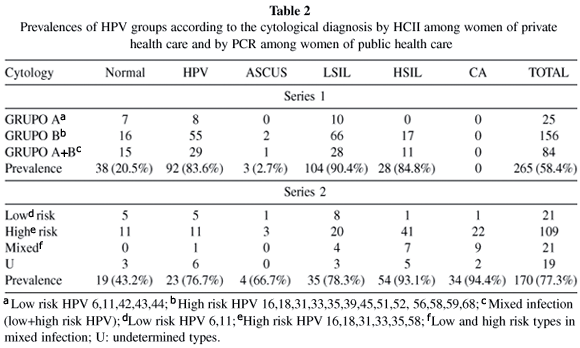This article reports the HPV status and cervical cytological abnormalities in patients attended at public and private gynecological services from Rio de Janeiro State. It also comments the performance of each HPV DNA tests used. A set of 454 women from private health clinics was tested by routine Capture Hybrid II HPV DNA assay. Among these, 58.4% presented HPV and nearly 90% of them were infected by high risk HPV types. However, this group presented few premalignant cervical lesions and no invasive cervical cancer was registered. We also studied 220 women from low income class attended at public health system. They were HPV tested by polymerase chain reaction using My09/11 primers followed by HPV typing with E6 specific primers. The overall HPV prevalence was 77.3%. They also showed a high percentage of high squamous intraepithelial lesion-HSIL (26.3%), and invasive cervical carcinoma (16.3%). HPV infection was found in 93.1% and 94.4% of them, respectively. The mean ages in both groups were 31.5 and 38 years, respectively. In series 1, HPV prevalence declined with age, data consistent with viral transient infection. In series 2, HPV prevalence did not decline, independent of age interval, supporting not only the idea of viral persistence into this group, but also regional epidemiological variations in the same geographic area. Significant cytological differences were seen between both groups. Normal and benign cases were the most prevalent cytological findings in series 1 while pre-malignant lesions were the most common diagnosis in the series 2. HPV prevalence in normal cases were statistically higher than those from series 1 (p < 0.001), indicating a higher exposure to HPV infection. Women from both samples were referred for previous abnormal cytology. However, socio-demographic evidence shows that women from series 1 have access to treatment more easily and faster than women from series 2 before the development of pre-malignant lesions. These data provides baseline support for the role of social inequalities linked to high risk HPV infection leading to cervical cancer. Broadly screening programs and the development of safe and effective vaccines against HPV would diminish the toll of this disease that affect mainly poor women.
Human papillomavirus; PCR; Hybrid capture; Cervical intraepithelial neoplasias; Socioeconomic factors




